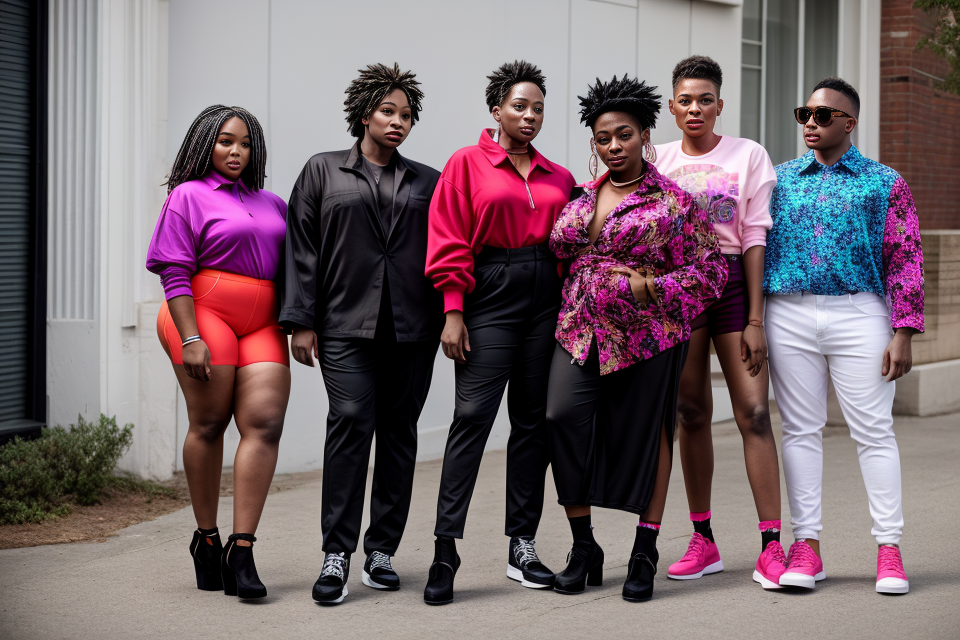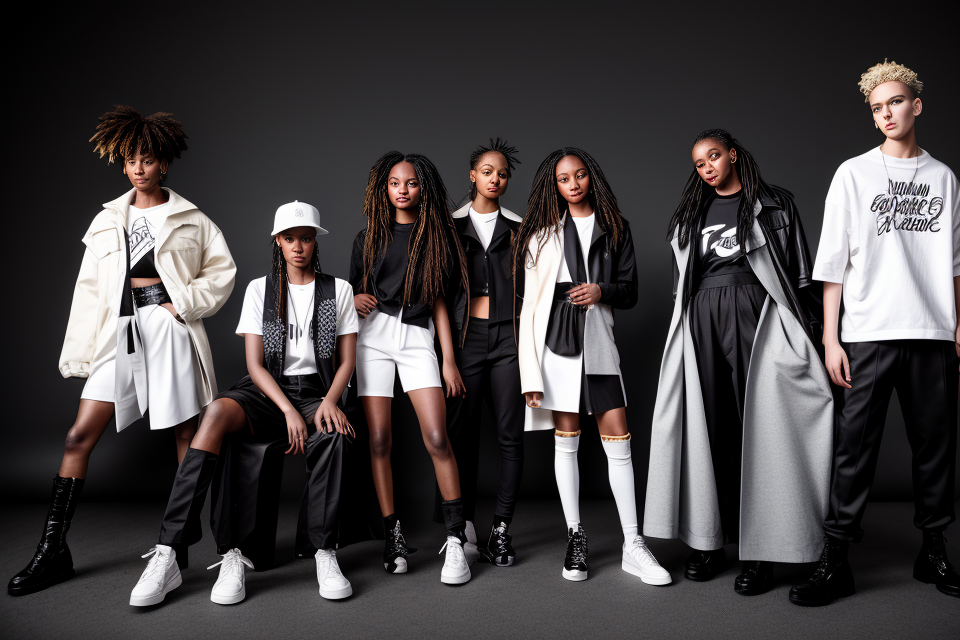In today’s world, gender-neutral fashion is becoming increasingly popular, especially among the black community. The concept of non-sexist dress codes is a key component of this movement, as it challenges traditional gender norms and stereotypes. Non-sexist dress codes encourage individuals to express their gender identity through their clothing choices, without fear of judgment or discrimination. In this article, we will explore the concept of non-sexist dress codes in gender-neutral fashion for black individuals, and how it promotes self-expression and acceptance.
The Importance of Non-Sexist Dress Codes in the Workplace
Understanding the Impact of Traditional Dress Codes on Black Individuals
Historical context of dress codes and their racial biases
Dress codes have been used throughout history to maintain social order and reinforce societal norms. However, these codes have often been used to discriminate against certain groups, including Black individuals. In the past, dress codes were used to identify and exclude Black people from certain spaces, such as restaurants, hotels, and other public areas. This historical context of dress codes has contributed to the racial biases that exist within them today.
How traditional dress codes reinforce gender norms and stereotypes
Traditional dress codes often reinforce gender norms and stereotypes, which can be particularly harmful to Black individuals. For example, dress codes that require women to wear dresses or skirts and men to wear suits and ties can perpetuate the idea that certain clothing is only appropriate for one gender. This can be particularly problematic for Black individuals who may not fit into these narrow gender categories. Additionally, dress codes that require certain hairstyles or grooming practices can also reinforce harmful stereotypes about Black hair and appearance.
The impact of dress codes on the professional and personal development of Black individuals
Dress codes can have a significant impact on the professional and personal development of Black individuals. For example, dress codes that require certain clothing or grooming practices may make it difficult for Black individuals to express their authentic selves in the workplace. This can lead to feelings of discomfort and insecurity, which can negatively impact their performance and professional growth. Additionally, dress codes that reinforce gender norms and stereotypes can limit the career opportunities available to Black individuals, as they may be seen as not fitting into traditional gender roles. Overall, traditional dress codes can have a significant impact on the professional and personal development of Black individuals, and it is important to consider the ways in which these codes may perpetuate harmful biases and stereotypes.
Benefits of Non-Sexist Dress Codes for Black Individuals
Enabling Black individuals to express their personal style and identity
- Black individuals have historically been restricted in their ability to express their personal style and identity due to discriminatory dress codes and societal expectations.
- Non-sexist dress codes allow Black individuals to wear clothing that reflects their unique cultural backgrounds and personal tastes, promoting a more inclusive and diverse workplace culture.
- By enabling Black individuals to express their personal style and identity, non-sexist dress codes help to create a more accepting and supportive work environment, where all employees feel valued and respected.
Promoting a more inclusive and diverse workplace culture
- Non-sexist dress codes promote a more inclusive and diverse workplace culture by allowing all employees to express themselves through their clothing choices, regardless of gender or race.
- Traditional dress codes often reinforce gender stereotypes and limit the choices available to employees, particularly those who identify as LGBTQ+ or who come from marginalized communities.
- By implementing non-sexist dress codes, employers can demonstrate their commitment to creating a workplace that is welcoming and inclusive for all employees, regardless of their background or identity.
Eliminating discrimination and harassment based on appearance
- Discrimination and harassment based on appearance are common in workplaces that have traditional, sexist dress codes.
- Women, particularly Black women, often face discrimination and harassment for wearing clothing that is deemed too revealing or too casual, while men may face backlash for wearing clothing that is deemed too feminine or too colorful.
- Non-sexist dress codes help to eliminate discrimination and harassment based on appearance by allowing all employees to wear clothing that is appropriate for the workplace, regardless of gender or race.
- This helps to create a more positive and respectful work environment, where all employees feel valued and respected.
The Challenges of Implementing Non-Sexist Dress Codes
Overcoming Resistance to Change
Addressing Common Misconceptions about Dress Codes
One of the main challenges in implementing non-sexist dress codes is addressing common misconceptions about dress codes. Many people believe that dress codes are necessary to maintain order and decorum in a workplace or social setting. However, this perspective often overlooks the ways in which dress codes can reinforce gender stereotypes and perpetuate discrimination against marginalized groups, including Black individuals.
To overcome resistance to change, it is important to challenge these misconceptions and educate others on the negative impacts of traditional dress codes. This can involve highlighting the ways in which dress codes can limit personal expression and creativity, as well as reinforcing harmful beauty standards and body ideals.
Encouraging Open Dialogue and Education on the Topic
Another key strategy for overcoming resistance to change is encouraging open dialogue and education on the topic. This can involve organizing workshops, seminars, or other educational events to educate individuals on the importance of non-sexist dress codes and the benefits of gender-neutral fashion for Black individuals.
These events can provide a safe space for individuals to ask questions, share their experiences, and learn from experts in the field. They can also help to build support for non-sexist dress codes and promote a culture of inclusivity and respect.
Developing a Clear and Comprehensive Policy for Non-Sexist Dress Codes
Finally, to overcome resistance to change, it is important to develop a clear and comprehensive policy for non-sexist dress codes. This can involve outlining specific guidelines for appropriate attire, as well as providing examples of clothing that is not acceptable in the workplace or social setting.
A comprehensive policy should also include provisions for accommodating individuals who may have religious or cultural objections to certain types of clothing, as well as policies for addressing complaints or violations of the dress code. By providing clear guidelines and a fair and consistent enforcement process, it is possible to overcome resistance to change and establish a culture of respect and inclusivity.
Navigating Legal and Ethical Considerations
When implementing non-sexist dress codes in the workplace, organizations must navigate various legal and ethical considerations. Here are some of the key challenges:
Ensuring Compliance with Relevant Laws and Regulations
Organizations must ensure that their dress codes comply with relevant laws and regulations. For example, Title VII of the Civil Rights Act of 1964 prohibits discrimination on the basis of race, color, religion, sex, or national origin. This means that dress codes cannot discriminate against employees based on their race or gender.
In addition, the Americans with Disabilities Act (ADA) requires employers to provide reasonable accommodations for employees with disabilities, which may include exceptions to dress code policies. Organizations must ensure that their dress codes do not violate these laws or create undue hardship for employees with disabilities.
Balancing the Rights of Individuals with the Goals of the Organization
Another challenge of implementing non-sexist dress codes is balancing the rights of individuals with the goals of the organization. Dress codes can impact an employee’s privacy, freedom of expression, and religious beliefs. Organizations must consider these factors when developing their dress code policies.
For example, an employee may have a religious belief that requires them to wear certain clothing or hairstyles. In these cases, organizations must provide reasonable accommodations to ensure that the employee’s rights are protected.
Addressing Potential Backlash or Negative Feedback from Employees
Finally, organizations must consider potential backlash or negative feedback from employees when implementing non-sexist dress codes. Some employees may resist changes to the dress code, feeling that it infringes on their personal expression or freedom.
To address this, organizations can involve employees in the development of the dress code policy, ensuring that their voices are heard and their concerns are addressed. Additionally, organizations can provide training and education to employees on the importance of non-sexist dress codes and how they contribute to a more inclusive workplace.
Strategies for Creating a Non-Sexist Dress Code
Collaborating with Employees and Stakeholders
Collaborating with employees and stakeholders is a crucial step in creating a non-sexist dress code that is inclusive of Black individuals. By involving Black employees and other underrepresented groups in the process, companies can gain valuable insights into the unique challenges and perspectives that these individuals face when it comes to dress codes. This collaboration can take several forms, including:
- Involving Black employees and other underrepresented groups in the process: Companies can create a diverse task force made up of employees from different backgrounds and experiences to help develop the dress code. This task force can work together to identify potential issues and provide feedback on how to make the dress code more inclusive.
- Seeking input and feedback from all stakeholders: Companies should not limit their input and feedback to just employees, but also reach out to customers, suppliers, and other stakeholders. This will ensure that the dress code is aligned with the values and expectations of the broader community.
- Building a consensus around the goals and guidelines of the dress code: It is important to have a clear understanding of the goals and guidelines of the dress code before implementing it. Companies should work with employees and stakeholders to build a consensus around what the dress code should achieve and how it should be enforced. This will help to ensure that everyone is on the same page and that the dress code is seen as fair and reasonable.
Overall, collaborating with employees and stakeholders is essential for creating a non-sexist dress code that is inclusive of Black individuals. By involving a diverse range of voices and perspectives in the process, companies can ensure that their dress code is truly inclusive and respectful of all individuals.
Developing Guidelines for Non-Sexist Dress Codes
- Establishing clear and specific definitions of appropriate attire
- Providing examples of acceptable and unacceptable dress
- Encouraging self-expression and personal style within the guidelines
Establishing clear and specific definitions of appropriate attire
To create a non-sexist dress code, it is crucial to establish clear and specific definitions of appropriate attire. This can be achieved by setting out guidelines that are free from gender stereotypes and biases. For instance, the dress code should define what is considered appropriate attire for all genders without creating unrealistic or unattainable standards. The guidelines should be inclusive and reflective of diverse body types, sizes, and shapes.
Providing examples of acceptable and unacceptable dress
Another strategy for developing non-sexist dress codes is to provide examples of acceptable and unacceptable dress. This can help to clarify the guidelines and ensure that everyone understands what is expected of them. Examples should be provided for all genders and should reflect the diversity of the workplace or the organization. The examples should also be realistic and achievable, avoiding the use of models that do not reflect the diversity of the workplace.
Encouraging self-expression and personal style within the guidelines
To promote a non-sexist dress code, it is important to encourage self-expression and personal style within the guidelines. This can be achieved by allowing individuals to express themselves through their clothing choices, as long as they adhere to the established guidelines. The guidelines should be flexible enough to allow for individuality while still maintaining the overall goal of creating a non-sexist dress code.
Overall, developing guidelines for non-sexist dress codes requires careful consideration of the needs and perspectives of all individuals, including those from diverse backgrounds and identities. By establishing clear and specific definitions of appropriate attire, providing examples of acceptable and unacceptable dress, and encouraging self-expression and personal style within the guidelines, organizations can create a more inclusive and equitable workplace environment.
Supporting Black Individuals in the Workplace
Creating a non-sexist dress code that supports Black individuals in the workplace requires a multi-faceted approach. It involves not only crafting policies that are inclusive of all gender identities, but also providing resources and support for Black employees as they navigate these policies. This section will explore some strategies for supporting Black individuals in the workplace:
Providing Resources and Support
To create a non-sexist dress code that supports Black individuals in the workplace, it is important to provide resources and support to help them navigate the policy. This can include providing training and education on the policy, as well as offering resources such as a dress code hotline or email address where employees can ask questions or report any issues. Additionally, it may be helpful to provide guidance on how to modify traditional gendered clothing items to make them more gender-neutral, such as wearing a skirt or dress with a shirt or jacket over it to create a more androgynous look.
Addressing Instances of Discrimination or Harassment
Discrimination and harassment based on dress code enforcement can be a serious issue for Black individuals in the workplace. It is important to have a clear policy in place for addressing these instances, and to ensure that employees feel comfortable reporting any incidents. This can include providing multiple avenues for reporting, such as an anonymous hotline or an online reporting system, as well as training managers and supervisors on how to respond to and address instances of discrimination or harassment.
Continuously Evaluating and Improving the Non-Sexist Dress Code Policy
Creating a non-sexist dress code is an ongoing process, and it is important to continuously evaluate and improve the policy over time. This can involve soliciting feedback from employees, as well as monitoring for any instances of discrimination or harassment. It may also involve conducting regular reviews of the policy to ensure that it remains relevant and effective in creating a supportive and inclusive workplace environment for Black individuals.
The Future of Non-Sexist Dress Codes in the Workplace
The Growing Importance of Gender-Neutral Fashion
The impact of social media and celebrity culture on gender-neutral fashion
Social media and celebrity culture have played a significant role in popularizing gender-neutral fashion. The rise of influencers and social media platforms has provided a platform for individuals to express their unique styles and challenge traditional gender norms. Celebrities such as Harry Styles, Jaden Smith, and Janelle Monáe have been praised for their gender-neutral fashion choices, which have helped to normalize the trend and encourage others to embrace it.
The rise of gender-neutral fashion brands and retailers
The growing demand for gender-neutral fashion has led to the emergence of new brands and retailers that cater to this market. These brands offer clothing that is designed to be worn by anyone, regardless of gender. They often use gender-neutral language in their marketing and product descriptions, and some even offer size inclusivity, which allows individuals of all shapes and sizes to feel included and represented.
The role of fashion in shaping cultural attitudes towards gender and identity
Fashion has long been a powerful tool for shaping cultural attitudes towards gender and identity. As more individuals embrace gender-neutral fashion, it is likely that cultural attitudes towards gender will continue to evolve. This shift towards gender-neutral fashion may also have a ripple effect on other areas of society, such as workplace dress codes and gendered spaces. By challenging traditional gender norms through fashion, individuals can help to create a more inclusive and equitable society for all.
The Potential for Lasting Change in the Workplace
- The potential for non-sexist dress codes to become a standard practice in the workplace
Implementing non-sexist dress codes in the workplace can have a lasting impact on how individuals perceive and interact with each other. As more companies adopt these policies, the norm of dressing in gender-neutral clothing can become a standard practice. This change in perspective can help break down the traditional gender roles that have been ingrained in society for centuries.
- The positive impact of non-sexist dress codes on workplace culture and diversity
Non-sexist dress codes can create a more inclusive and diverse workplace culture. By allowing individuals to express themselves through their clothing choices, it promotes a sense of individuality and self-expression. This, in turn, can foster a more accepting and understanding environment for all employees, regardless of their gender identity or expression.
- The potential for non-sexist dress codes to contribute to broader social change
The adoption of non-sexist dress codes in the workplace can have a ripple effect on society as a whole. As more companies implement these policies, it can lead to a shift in societal norms and expectations. This change can help break down barriers and stereotypes, promoting a more equitable and inclusive society for all individuals, regardless of their gender identity or expression.
Addressing the Challenges and Embracing the Opportunities
- The Importance of Ongoing Dialogue and Education on the Topic
- Encouraging open and honest conversations about gender and identity in the workplace
- Providing resources and training for employees and managers on how to create and maintain a respectful and inclusive environment
- Regularly reviewing and updating dress code policies to ensure they align with the organization’s values and goals
- The Potential for Non-Sexist Dress Codes to Foster Greater Inclusivity and Diversity in the Workplace
- Creating a more welcoming and supportive environment for individuals of all gender identities and expressions
- Promoting a culture of respect and understanding, where everyone feels valued and respected
- Attracting and retaining a diverse workforce by demonstrating a commitment to inclusivity and equality
- The Opportunity for Organizations to Lead by Example and Promote Positive Social Change
- Setting a positive example for other organizations and industries to follow
- Contributing to a broader movement towards greater equality and justice in society
- Making a meaningful impact on the lives of black individuals and other marginalized groups by promoting a more inclusive and equitable workplace culture
FAQs
1. What is a non-sexist dress code?
A non-sexist dress code is a set of guidelines that promote gender-neutrality and inclusivity in clothing choices. It encourages individuals to dress in a way that feels authentic to them, without being bound by traditional gender norms. A non-sexist dress code can be particularly important for Black individuals, who often face discrimination and marginalization based on their race and gender.
2. Why is a non-sexist dress code important for Black individuals?
For Black individuals, adhering to traditional gender norms and dress codes can be a form of oppression. A non-sexist dress code allows Black individuals to express themselves freely and authentically, without fear of judgment or discrimination. It also promotes the idea that clothing choices should not be used as a means of enforcing gender norms or stereotypes.
3. What does a non-sexist dress code look like?
A non-sexist dress code can take many forms, but it typically involves allowing individuals to dress in a way that feels authentic to them, without being bound by traditional gender norms. This can include clothing that is typically associated with one gender or another, as well as clothing that is gender-neutral or androgynous. The key is to promote inclusivity and acceptance of all individuals, regardless of their gender identity or expression.
4. How can I implement a non-sexist dress code in my workplace or school?
Implementing a non-sexist dress code in your workplace or school involves creating a set of guidelines that promote inclusivity and acceptance of all individuals. This can include educating employees or students about the importance of gender-neutrality and inclusivity in clothing choices, as well as providing resources and support for individuals who may face discrimination or marginalization based on their gender identity or expression. It’s important to involve members of the community in the process of creating and implementing the dress code, to ensure that it is inclusive and reflective of everyone’s needs and perspectives.



